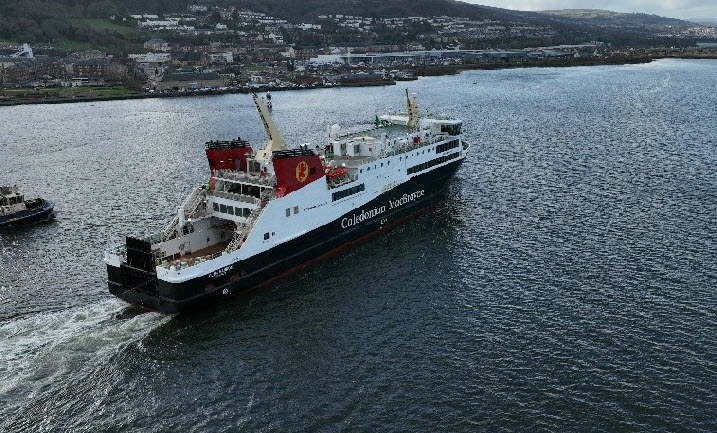Fresh delays to finishing off essential work on MV Glen Sannox will prevent her from commencing passenger sailings until the peak summer period is over.
Ongoing difficulties with critical tasks to install final elements of the ferry’s dual fuel LNG system will hold back her completion at the Ferguson shipyard on the River Clyde.
The Sannox is desperately needed on her designated Arran service which is suffering economic pain following the withdrawal for major repairs of their main ferry, MV Caledonian Isles.
Missing yet another revised delivery deadline of 31 May by two months to the end of July means MV Glen Sannox is unlikely to be available for commercial sailings until October after CalMac crew familiarisation trials take place.
By the time she carries her first passenger, the Scottish school holidays will be just a faded memory for the country’s children. September sees passenger numbers tailing off as classes resume for pupils south of the border.
The Sannox ship has relocated to Greenock as efforts struggle on with her onboard gas fuel network.
Risk of failure to meet target delivery dates due to the gas fuel system has been
regularly highlighted with a code red status under the traffic light colours’ rating
adopted by the multi-agency group monitoring the final stages of the build and handover
arrangements.
Members of the group consist of the top bosses at CalMac and Ferguson Marine as well as senior civil servants with the Scottish Government and Transport Scotland. The government’s ferry owning agency, CMAL, also has representatives on the group.
While much of the overall liquefied natural gas (LNG) system is on the vessel, the
hold-up was due to serious hitches with the final sections of special piping to handle
extreme low temperatures up to -170ºC.
The desperately hoped for official approval from inspectors from the MCA, the UK’s shipping regulator, depends on successfully commissioning the whole system and sea trials to demonstrate the vessel can switch seamlessly between marine oil and LNG fuels.
Supplier problems came to a head towards the end of last year. A Scottish based contractor was then called in to fabricate and install gas piping while Finnish technology firm Wartsila is overseeing the commissioning phase.
Despite being apparently on schedule in January the revised LNG programme drifted awry.
John Petticrew, Ferguson’s chief executive, stated: “The installation and commissioning of the LNG system, a first in class for UK shipbuilding, remains particularly challenging.
“An underestimation of complexity, the degree of difficulty of the installation, the lack of available expert knowledge and qualified resources in the UK in relation to marine LNG systems, has disappointingly contributed to further slippage in the progress that we have been able to make in the last few weeks, and consequently our previously proposed schedule.
“Regrettably, this will result in a delay of the delivery of this fully commissioned dual fuel system vessel, now targeted for the end of July 2024.”
The Sannox undertook a second round of sea trials recently and also entered drydock earlier this month to clean her external steelwork and undergo a crucial hull inspection by the MCA.
John Petticrew has stepped in as chief executive of Ferguson Marine shipyard after David Tydeman was sacked last month.
Mr Tydeman - who was in the job for two years - had his contract suddenly terminated
amid a revamp of senior appointments aimed at putting the company on a secure footing
for its long term future.
Both MV Glen Sannox and MV Glen Rosa should have been in service in 2018 on the lifeline ferry routes operated by CalMac, under the original contract between the Scottish Government and Ferguson Marine.
Building costs have soared and are now in excess of £300 million compared to the original price tag of £97 million.
MV Glen Sannox set to miss CalMac busy tourism season following latest delay
20 April 2024
